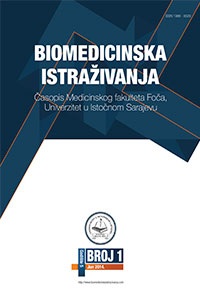Switching therapy in patients with age-related macular degeneration, diabetic macular edema and cistoid macular edema due to retinal vein occlusion
DOI:
https://doi.org/10.7251/BII1901064RAbstract
Introduction. Intravitreal injection of anti-vascular endothelial growth factor
(VEGF) agents has revolutionized the management of age-related macular
degeneration (AMD), diabetic macular edema (DME), macular edema
in retinal vein occlusions (RVO), and other retinal diseases accompanied by
neovascular and macular edema. The aim of the study is to show the effect
of switching from bevacizumab to aflibercept in patients with recalcitrant
wet AMD as the best clinical approach and regimen for patients with neovascular
and macular edema accompanied retinal diseases.
Methods. All our patients received the intravitreal injections of 1.25 mg
(0.1 mL) bevacizumab as the first treatment option, and we switched to
aflibercept or triamcinolon acetonid when the therapy including bevacizumab
seemed not to be effective enough, according to visual acuity and
optical coherent tomography (OCT) findings.
Case presentations. We presented four cases: two patients with wet AMD,
one patient with macular edema due to central retinal vein occlusion (CRVO)
and one patient with DME in non-proliferative diabetic retinopathy (nPDR).
The majority of our patients felt visual and anatomical improvement. Some
patients felt anatomical improvement although their visual acuity did not
improve. Switch to aflibercept had prolonged the positive effect of bavacizumab
for approximately 2 months. When regular therapy including bevacizumab
was reintroduced, the therapeutic effect would be prolonged.
The effective clinical approach was not only the switching therapy but the
combination therapy as well. Individual treatment approach and pro re
nata regimen were most commonly used in our patients.
Conclusion. Switching anti-VEGF drug showed positive results in patients
with refractory or recurrent wet AMD and macular edema.

